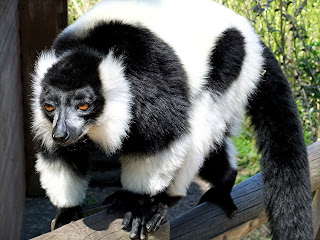Exquisite illustration of the red ruffed lemur Varecia rubra, in A Hand-Book to the Primates, Plate VII, 1894 (public domain)
Despite being officially deemed to have
become extinct several centuries ago at the very least, the possibility that some
of Madagascar's giant lemurs persisted into modern times and may still be doing
so today has always fascinated me, ever since as a teenager back in the early
1970s I first read the famous chapter devoted to this island mini-continent's
mystery beasts in Dr Bernard Heuvelmans's classic cryptozoology book On the
Track of Unknown Animals. The most celebrated Madagascan cryptids that may
be late-surviving giant lemurs include the tratratratra, kidoky, tokandia,
habéby, mangarsahoc, kalanoro, and kotoko (see my book Mirabilis for extensive coverage).
My much-read, greatly-treasured, massively-influential copy of
the 1972 abridged Paladin Books paperback edition of On the Track of Unknown Animals (© Dr Karl Shuker/Paladin)
On 5 November 2018, however, the American
TV documentary channel Animal Planet posted on YouTube a video in which
wildlife adventurer Forrest Galante was seeking a mystery lemur that I had
never seen documented anywhere before (click here
to access the video).
The locals describe it as a giant red
lemur, and refer to it as the kisuala. In the video's description, the question
is posed as to whether this cryptid may be a surviving species of Pachylemur
- a two-species genus of extinct giant lemur that may have survived until at
least as recently as 500 years ago.
Life
restoration of Pachylemur insignis, based upon a photograph of a skull, a
photograph of a skeleton, restoration by Stephen Nash, and correspondence with
Dr Laurie Godfrey (© Smokeybjb/Wikipedia – CC BY-SA 3.0 licence)
They are known colloquially as giant ruffed
lemurs, because they were most closely related to the somewhat smaller but still-living
Varecia ruffed lemurs. One of these,
the red ruffed lemur Varecia rubra, does indeed have predominantly – and
very prominently – red fur,
I don't think that I'm including a spoiler for
viewers about to watch the video by saying that Forrest's search for the
kisuala was unsuccessful – after all, had it been successful it would have made
major headlines worldwide. However, it is always exciting to publicise a
cryptid not previously documented within the cryptozoological literature, and
we can but hope that future searches for this intriguing animal will be made.
The
black-and-white ruffed lemur V. variegata,
closely related to V. rubra – indeed,
until 2001 they were treated merely as subspecies of a single species of ruffed
lemur, but they exhibit sufficient genetic differences to warrant being
elevated to full species in their own right (© Dr Karl Shuker)




























On an interesting note, Galante did later recover a Madagascan hippo skull supposedly under 200 years old (800 or so years after it was supposed to be gone), giving recent stories of the Kilopilopitsofy and Tsomgomby.
ReplyDeleteYes indeed, I saw that, but it was subsequently discounted by various scientists as being of such recent date. I think that I have some of the responses to it on file.
DeleteCan you show me where they say, they think it's not less than 200 years old.
DeleteSource details are here: https://www.zoochat.com/community/threads/malagasy-dwarf-hippo-may-still-be-alive.474545/
Delete